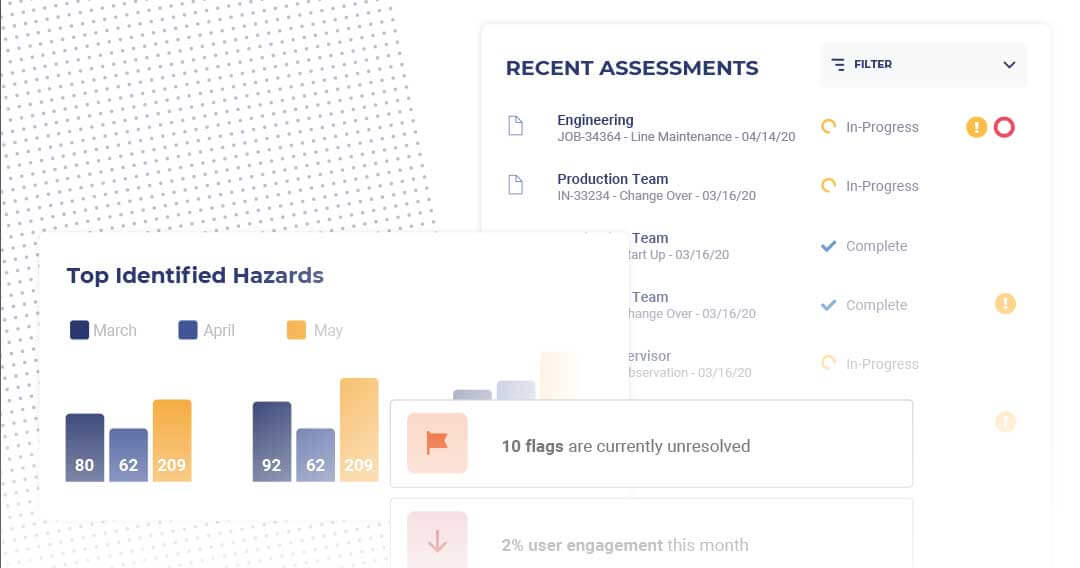Schedule a demo
Want to learn more? Schedule a demo with us.
Lagging and Leading Indicators in Safety: Understanding Key Metrics for Workplace Safety
In occupational health and safety, organizations employ various tools to monitor and assess safety performance. Two important metrics used for this purpose are leading indicators and lagging indicators. These indicators provide valuable insights into the effectiveness of safety programs, policies, and practices, enabling organizations to identify potential risks and improve workplace safety proactively. In this article, we will explore the concepts of leading and lagging indicators, provide examples of each, and highlight their significance in promoting health and safety in the workplace.

What Is A Leading Indicator In Safety?
Leading indicators in safety are proactive measures that help predict and prevent accidents or injuries. These indicators focus on identifying potential risks and taking preventive actions to mitigate them. By monitoring leading indicators, organizations can evaluate the effectiveness of their safety programs and measure proactive behaviors that reduce the likelihood of incidents. Leading indicators safety examples effectively demonstrate the importance of these measures.
Some examples of safety leading indicators examples include:
1. Near-miss reporting
Encouraging employees to report near-miss incidents provides valuable data on potential hazards and can help prevent similar accidents in the future. By tracking the number of near-miss reports, organizations can assess the level of engagement and identify areas for improvement in their safety protocols.
2. Safety training participation
Monitoring the participation rates in safety training programs indicates employee commitment to safety practices. By ensuring high participation levels, organizations can enhance employee knowledge and awareness of safety procedures, thereby reducing the risk of accidents.
3. Safety observations
Regular safety observations allow organizations to identify potential hazards and assess adherence to safety protocols. Organizations can prevent accidents and promote a safety-conscious culture by monitoring the number of safety observations conducted and acting upon the findings.
4. Implementation of safety procedures
Tracking the implementation of safety procedures and protocols, such as the use of personal protective equipment (PPE) or equipment maintenance schedules, provides insights into compliance levels and the effectiveness of risk control measures.
What Are Lagging Indicators?
On the other hand, lagging indicators in safety provide retrospective information on incidents and injuries that have already occurred. These indicators offer insights into the effectiveness of safety management systems, controls, and response measures. While lagging indicators are reactive in nature, they are valuable for identifying trends, assessing the severity of incidents, and informing future safety strategies.
Safety lagging indicators examples include:
1. Total recordable incidents
This metric captures the overall number of incidents, including injuries, illnesses, and near-fatal accidents, within a specific timeframe. Tracking the total recordable incidents provides organizations with an overview of their safety performance and helps identify areas that require improvement.
2. Lost-time injury frequency rates
This indicator measures the number of injuries that result in lost workdays per unit of time. It highlights the severity of injuries and enables organizations to evaluate the impact of incidents on productivity and employee well-being.
3. Injury severity rates
By quantifying the severity of injuries based on factors such as medical treatment required or days away from work, organizations can assess the impact of incidents on employees and prioritize preventive measures accordingly.
Health and safety indicators encompass both leading and lagging indicators and form a comprehensive framework for evaluating safety performance. By combining proactive leading indicators and retrospective lagging indicators, organizations can gain a holistic understanding of their safety efforts. These indicators enable organizations to identify potential risks, monitor compliance with safety protocols, measure the effectiveness of safety programs, and continuously improve their safety management systems.
The Importance of Leading and Lagging Indicators
Leading and lagging indicators are both crucial aspects of ensuring organizational safety. While lagging indicators focus on the outcome of incidents that have occurred, leading indicators concentrate on the measures taken to prevent accidents from happening in the first place.
Lagging indicators are often used as a reactive approach to safety, as they provide details on the accidents and incidents that have already taken place. These indicators include injury rates, the number of lost workdays, and the costs incurred due to accidents. Analyzing lagging indicators can help organizations identify problem areas and take corrective measures to prevent similar accidents from happening in the future.
On the other hand, leading indicators provide a proactive approach to safety by enabling organizations to identify and mitigate potential hazards before they lead to accidents. These indicators include the number of safety inspections conducted, the frequency of safety training, and the use of personal protective equipment. By focusing on leading indicators, organizations can create a culture of safety, which can help prevent accidents from happening altogether.
Both leading and lagging indicators are essential in ensuring organizational safety. While lagging indicators provide valuable insights into past accidents, leading indicators help organizations take proactive steps to prevent future incidents. By utilizing both types of indicators, organizations can create a safer workplace for their employees, which can lead to improved productivity, increased employee morale, and reduced costs associated with accidents.
Leading and lagging indicators are essential tools for monitoring and assessing safety performance in the workplace. Leading indicators focus on proactive measures and behaviors that help prevent incidents while lagging indicators provide retrospective information on incidents and injuries. By employing a combination of leading and lagging indicators, organizations can enhance their safety programs, promote a safety-conscious culture, and prioritize resources to ensure the well-being of their employees.
Safety Leading Indicators Scorecard and KPIs: Enhancing Safety Performance Measurement
To effectively manage and improve safety performance, organizations utilize various tools and metrics, including safety leading indicators, scorecards, and Key Performance Indicators (KPIs). These tools provide valuable insights into proactive safety measures, allowing organizations to monitor, measure, and enhance their safety programs. In this article, we will delve into the concept of a safety leading indicators scorecard, discuss its key components, and explore the essential KPIs that organizations should measure to drive continuous safety improvement.
Balanced Scorecard for Safety
A safety-leading indicators list, also known as an Environmental, Health, and Safety (EHS) scorecard, is a comprehensive tool that enables organizations to track and evaluate their safety performance based on proactive leading indicators. This scorecard goes beyond lagging indicators, such as incident rates, and focuses on metrics that assess the effectiveness of safety programs, training initiatives, and risk control measures.
Here are key components that organizations should consider when developing a safety leading indicators scorecard:
- Near-miss reporting
- Safety training participation
- Safety observations
- Safety procedure implementation
- Employee engagement

Safety KPIs
In addition to a safety-leading indicators scorecard, organizations should establish Key Performance Indicators (KPIs) specific to safety to measure the overall effectiveness of their safety programs. These KPIs help organizations gauge their safety performance and identify areas that require improvement. They provide insights into the effectiveness of an organization's safety program and help identify areas for improvement. Safety KPIs can be implemented by setting specific safety goals, such as reducing the number of accidents or improving safety training. These goals should be measurable and tied to specific metrics, such as the number of safety inspections conducted or the frequency of safety incidents.
By regularly tracking and analyzing safety KPIs, organizations can identify trends, implement corrective actions, and continuously improve their safety performance. Implementing safety KPIs can help create a culture of safety, improve employee morale, and reduce costs associated with accidents.
Here are some essential KPIs that organizations should consider measuring:
1. Incident Rates
While incident rates are lagging indicators, they are still crucial for evaluating safety performance. Measuring metrics such as Total Recordable Incident Rate (TRIR) or Lost Time Incident Frequency Rate (LTIFR) helps organizations understand the frequency and severity of incidents.
2. Compliance with safety regulations
Ensuring compliance with local, regional, and industry-specific safety regulations is vital. Measuring metrics related to regulatory compliance, such as the number of safety inspections or compliance audits conducted, helps organizations identify any gaps and take corrective actions
3. Safety training effectiveness
Measuring the effectiveness of safety training programs is essential for assessing employee knowledge and understanding of safety procedures. Metrics such as training completion rates, post-training assessments, or feedback surveys can provide insights into the impact of training initiatives on safety performance.
4. Safety culture assessment
Assessing the organization's safety culture helps identify the overall attitudes, beliefs, and behaviors related to safety. Metrics such as employee perception surveys, safety perception scores, or safety culture assessments provide a holistic view of the organization's safety culture and highlight areas for improvement.
5. Continuous improvement initiatives
Measuring metrics related to continuous safety improvements, such as the number of safety suggestions implemented or the effectiveness of corrective actions, demonstrates the organization's commitment to ongoing safety enhancement.
By incorporating these KPIs into their safety measurement framework, organizations can effectively monitor and improve their safety performance. It is important to regularly review and analyze the data from the safety leading indicators scorecard and KPIs to identify trends, address gaps, and allocate resources to areas that require improvement.
The Importance of Workplace Safety
In conclusion, a safety leading workplace indicators scorecard and KPIs are crucial tools for organizations to measure and enhance their safety performance. A comprehensive scorecard should include metrics such as near-miss reporting, safety training participation, safety observations, safety procedure implementation, and employee engagement. Furthermore, organizations should establish KPIs related to incident rates, compliance with safety regulations, safety training effectiveness, safety culture assessment, and continuous improvement initiatives. By leveraging these tools, organizations can proactively identify and address safety risks, foster a strong safety culture, and drive continuous safety improvement.
Anvl: Let’s Get to Work
Ready to see how Anvl can impact your organization? Contact one of our experts today.

